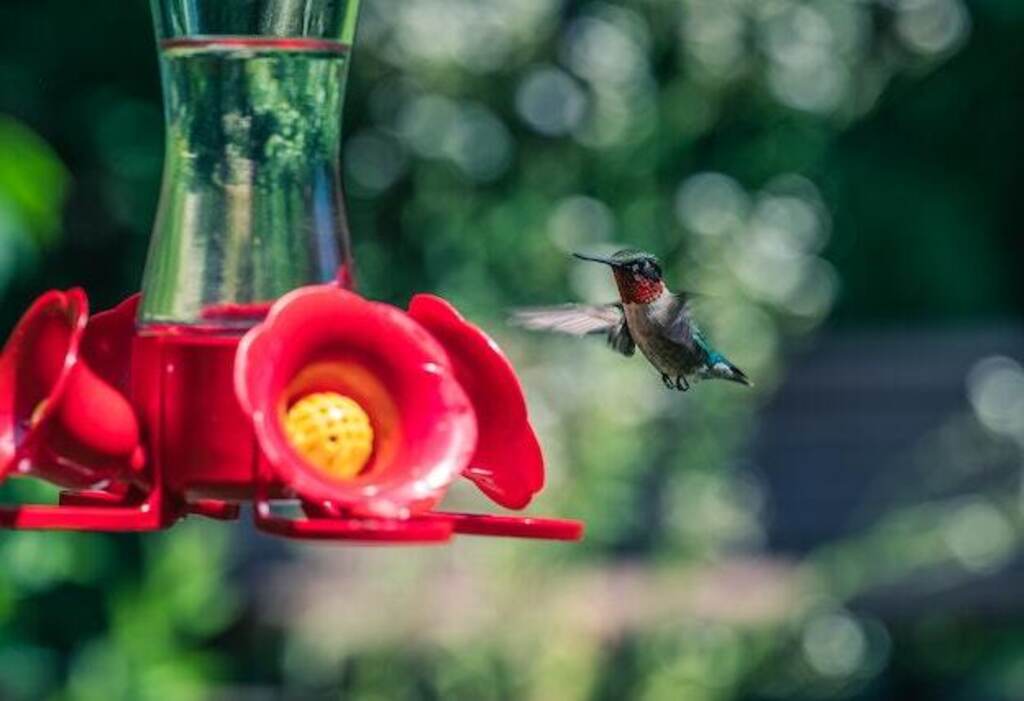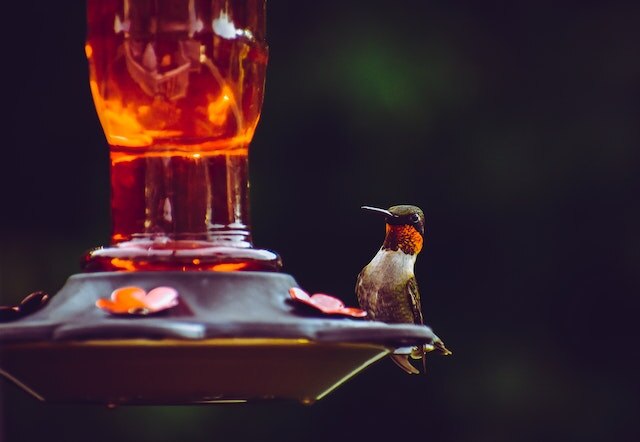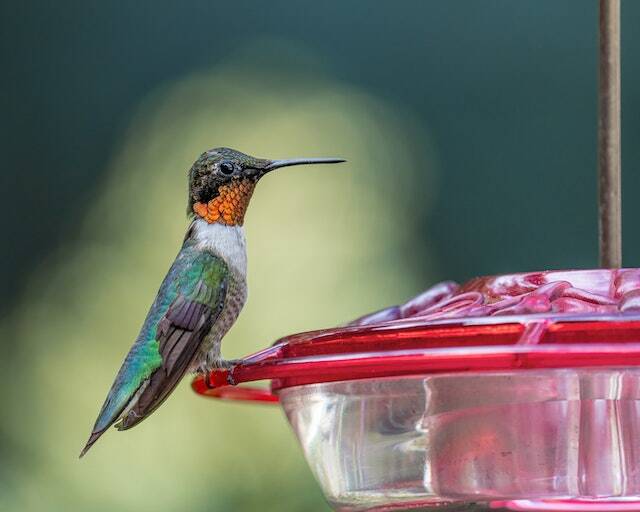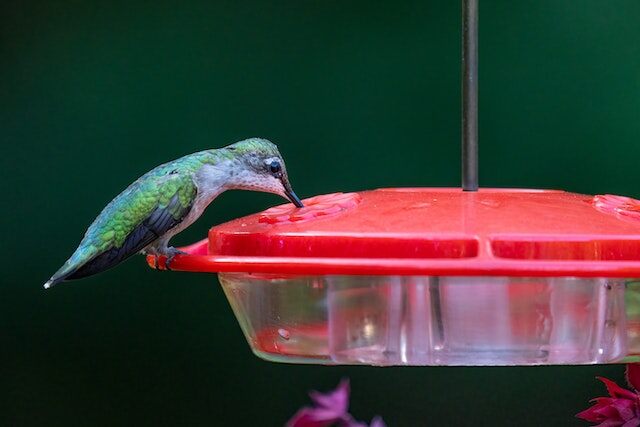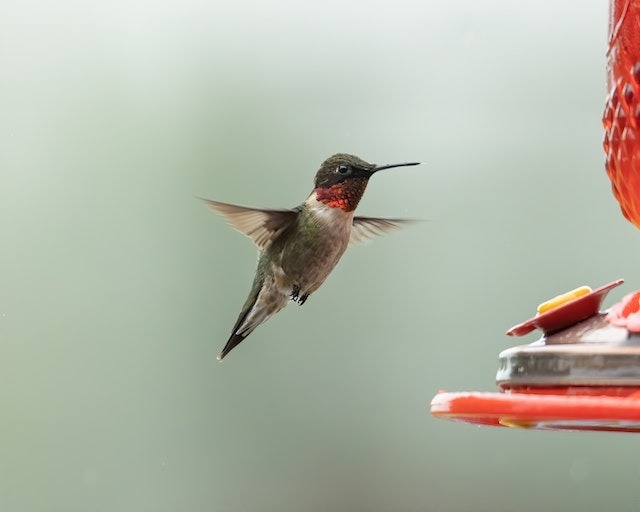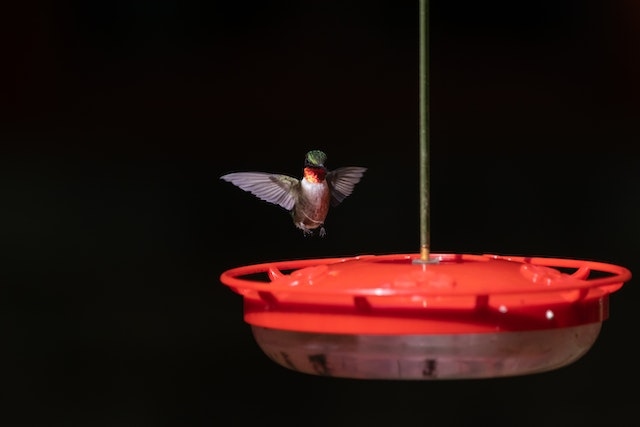As a hummingbird enthusiast, it’s crucial to understand the shelf life of hummingbird nectar to ensure optimal feeding and attraction of these lovely birds. Hummingbirds depend on nectar as their primary source of fuel, and providing them with fresh nectar not only helps them thrive, but also enhances the chances of regular visits to your feeder.
In this guide, we’ll explore various factors affecting the lifespan of hummingbird nectar, optimal storage methods, signs of spoiled nectar, and ways to attract hummingbirds with fresh nectar.
We’ll also cover DIY hummingbird nectar recipes, cleaning and maintenance of hummingbird feeders, common mistakes to avoid when feeding hummingbirds, seasonal considerations, and alternatives to traditional nectar.
Table of Contents
- 1 Key Takeaways:
- 2 How Long Does Hummingbird Nectar Last?
- 3 Factors Affecting Hummingbird Nectar Lifespan
- 4 Optimal Storage Methods for Hummingbird Nectar
- 5 Signs of Spoiled Hummingbird Nectar
- 6 Tips for Attracting Hummingbirds with Fresh Nectar
- 7 DIY Hummingbird Nectar Recipes
- 8 Cleaning and Maintenance of Hummingbird Feeders
- 9 Common Mistakes to Avoid When Feeding Hummingbirds
- 10 Seasonal Considerations for Hummingbird Nectar
- 11 Alternatives to Traditional Hummingbird Nectar
- 12 Best Practices for Responsible Hummingbird Feeding
- 13 In Conclusion
- 14 FAQs: How Long Does Hummingbird Nectar Last?
- 14.1 How long does hummingbird nectar last?
- 14.2 What factors can affect the lifespan of hummingbird nectar?
- 14.3 What are the optimal storage methods for hummingbird nectar?
- 14.4 What are the signs of spoiled hummingbird nectar?
- 14.5 How can I attract hummingbirds with fresh nectar?
- 14.6 Are there DIY hummingbird nectar recipes?
- 14.7 How should I clean and maintain hummingbird feeders?
- 14.8 What common mistakes should I avoid when feeding hummingbirds?
- 14.9 How do seasonal considerations affect hummingbird nectar?
- 14.10 Are there alternatives to traditional hummingbird nectar?
- 14.11 What are the best practices for responsible hummingbird feeding?
- 14.12 In conclusion, what is the importance of understanding how long hummingbird nectar lasts?
- 15 Author
Key Takeaways:
- Understanding the shelf life of hummingbird nectar is crucial for attracting and feeding hummingbirds.
- Freshness of nectar depends on factors such as exposure to sunlight, temperature, contamination, and microbial growth.
- Proper storage methods, regular cleaning of feeders, and avoiding common mistakes can help prolong the lifespan of hummingbird nectar.
- Seasonal considerations and alternative nectar sources should also be taken into account for responsible hummingbird feeding.
How Long Does Hummingbird Nectar Last?
Hummingbird nectar can last for different amounts of time depending on the temperature and humidity. In general, nectar should be changed every 2–3 days in hot weather to prevent fermentation and growth of harmful bacteria.
In cooler temperatures, nectar can last up to a week before it needs to be changed. It is important to clean the feeder thoroughly each time the nectar is changed to prevent the build-up of mold and bacteria.
To make hummingbird nectar, mix one part white granulated sugar with four parts water and boil for one to two minutes. Let the nectar cool before filling the feeder. Do not use honey, brown sugar, or artificial sweeteners, as they can be harmful to hummingbirds.
Factors Affecting Hummingbird Nectar Lifespan
Hummingbirds are delicate creatures that require fresh nectar to maintain their energy levels. Therefore, it is essential to understand the factors that can affect the lifespan of hummingbird nectar. Proper management of hummingbird food is crucial to avoid attracting insects or causing harm to the birds.
Prolonging hummingbird nectar lifespan:
Several factors can affect the lifespan of hummingbird nectar, including exposure to sunlight, temperature, contamination, and microbial growth. To prolong the lifespan of nectar, it is important to minimize exposure to sunlight and high temperatures as much as possible. Store the nectar in a cool, shaded location to prevent spoilage and fermentation.
Contamination is another key factor to consider when preserving nectar for hummingbirds. Avoid using dirty or contaminated feeders and containers. Use clean containers to prepare and store the nectar, and clean the containers regularly. This will also prevent the growth of bacteria or fungi that can spoil the nectar quickly.
Preserving nectar for hummingbirds:
Proper storage methods are essential to maintaining the freshness and quality of hummingbird nectar. Refrigeration is a great way to keep the nectar fresh for longer periods. Avoid using preservatives or additives such as honey or artificial sweeteners, as they can cause harm to hummingbirds.
It is important to check the nectar regularly for signs of spoilage and adjust the feeding schedule accordingly. To extend the lifespan of hummingbird nectar, it is recommended to change the nectar every two to three days during hot weather and every four to five days in cooler weather.
By understanding the factors that can affect the lifespan of hummingbird nectar, and following proper storage and feeding practices, you can provide fresh and healthy nectar for hummingbirds all year round.
Optimal Storage Methods for Hummingbird Nectar
Hummingbirds are attracted to fresh nectar, making it essential to maintain the quality of the food by following proper storage methods. To keep hummingbird nectar fresh and preserve its nutrients, consider the following tips:
- Use clean containers: Always use clean, food-grade containers to store hummingbird nectar. Containers that have been used for other purposes or that have not been properly cleaned may contaminate the nectar with harmful chemicals or microbes.
- Refrigerate the nectar: Refrigeration is an effective way to prolong the shelf life of hummingbird nectar. Simply store the nectar in a sealed container in the refrigerator for up to one week.
- Avoid preservatives and additives: Some people may be tempted to add preservatives or other substances to hummingbird nectar to prolong its shelf life. However, it’s best to avoid these additives, as they may not be safe for hummingbirds to consume.
- Store in a cool, dark place: Exposure to direct sunlight or heat can cause hummingbird nectar to spoil more quickly. Therefore, it’s best to store the nectar in a cool, dark place, away from direct sunlight or other sources of heat.
By following these methods, you can help ensure that the hummingbird nectar you provide is fresh and nutrient-rich, which can help attract more hummingbirds to your feeder. Remember to always replace the nectar every few days, or sooner if it appears cloudy or discolored.
Signs of Spoiled Hummingbird Nectar
Hummingbird nectar has a limited lifespan, and it is essential to know the signs of spoilage to ensure these beautiful birds receive the best care possible. While nectar can differ in terms of the optimal duration, most hummingbird nectar lasts for about one to two weeks. When the nectar sits in the feeder for an extended period, it may start to go bad, and feeding hummingbirds with spoiled nectar might make them sick. Therefore, it is crucial to identify the signs of spoiled hummingbird nectar and replace it immediately.
Here are signs to look out for:
- Changes in Color: Hummingbird nectar that has gone bad tends to have a cloudy or milky appearance, indicating that it has started to ferment.
- Odor: When hummingbird nectar goes bad, it develops a sour or unpleasant smell.
- Mold or Fungus: If you notice any mold or fungus in the feeder or on the nectar’s surface, it is a clear indication that the nectar has gone bad and must be replaced immediately.
Feeding hummingbirds with spoiled nectar is harmful to their health and may lead to various diseases. If you notice any signs of spoilage in the nectar, it is best to replace it right away. Observing the optimal duration for hummingbird nectar and storing it correctly can help prolong its lifespan and ensure that hummingbirds receive the best care possible.
Tips for Attracting Hummingbirds with Fresh Nectar
Attracting hummingbirds with fresh nectar requires more than just filling up a feeder with sugar water. Here are some tips to help preserve the longevity of hummingbird nectar and keep your feathered friends coming back for more:
1. Regular Nectar Changes
Hummingbird nectar can spoil quickly, especially in warmer temperatures. It’s important to change the nectar every 2-3 days to ensure that it stays fresh and doesn’t become contaminated with bacteria or mold.
2. Cleanliness of Feeders
Keeping hummingbird feeders clean is essential to maintaining the freshness of nectar. Use hot water and a bottle brush to clean feeders thoroughly before refilling them. Avoid using soap or other chemicals that could be harmful to hummingbirds.
3. Proper Placement of Feeders
Hummingbirds prefer feeders that are placed in open areas, away from any predators or hazards. Hang feeders in shaded areas to prevent the nectar from spoiling too quickly in direct sunlight. You can also place feeders near flowers or plants that attract hummingbirds to create a natural feeding environment.
4. Use Fresh and Clean Water
Use fresh and clean water when making nectar to ensure that it stays fresh for longer. Avoid using tap water that contains chlorine or other chemicals that could be harmful to hummingbirds. Use filtered or distilled water instead.
5. Avoid Using Additives or Preservatives
Adding red food coloring or other additives to nectar can be harmful to hummingbirds and reduce the longevity of the nectar. Stick to plain sugar water to attract and feed hummingbirds.
6. Provide Natural Food Sources
Hummingbirds rely on natural nectar sources, such as flowers and plants, for their diet. Planting hummingbird-friendly flowers and plants in your yard can provide an alternative food source for hummingbirds and reduce their dependence on supplemental feeding.
7. Monitor Feeding Activity
Keep an eye on the feeding activity at your hummingbird feeders to ensure that they are not becoming overcrowded. Too many hummingbirds competing for nectar can lead to aggression and territorial behavior. If you notice overcrowding, consider adding additional feeders to spread out the feeding activity.
By following these tips, you can preserve the longevity of hummingbird nectar and attract these beautiful birds to your yard for a rewarding and enjoyable experience.
DIY Hummingbird Nectar Recipes
Preserving nectar for hummingbirds is essential to keep these beautiful birds coming back to your feeder. Store-bought nectar may contain additives and preservatives, which can affect the lifespan of nectar. Making your own hummingbird nectar is easy, inexpensive, and provides a natural food source for these aerial acrobats. Here are some DIY nectar recipes that can help you extend the lifespan of hummingbird nectar:
Recipe 1: Basic Hummingbird Nectar
| Ingredients | Ratios |
|---|---|
| White granulated sugar | 1 part |
| Water | 4 parts |
Note: Do not add food coloring, honey, or other sweeteners to nectar.
To make the nectar, mix one part white granulated sugar to four parts water. Bring the mixture to a boil and continue stirring until all the sugar is dissolved. Allow the solution to cool before filling your feeder. Refrigerate any extra nectar for up to two weeks.
Recipe 2: Honey Substitute
| Ingredients | Ratios |
|---|---|
| White granulated sugar | 1 part |
| Water | 3 parts |
| Corn syrup | 1 part |
Note: Corn syrup can be used as a substitute for honey.
To make the nectar, mix one part white granulated sugar to three parts water. Bring the mixture to a boil and continue stirring until all the sugar is dissolved. Add one part corn syrup and stir until fully combined. Allow the solution to cool before filling your feeder. Refrigerate any extra nectar for up to two weeks.
Recipe 3: Agave Nectar Substitute
| Ingredients | Ratios |
|---|---|
| White granulated sugar | 1 part |
| Water | 3 parts |
| Agave nectar | 1 part |
Note: Agave nectar can be used as a substitute for honey.
To make the nectar, mix one part white granulated sugar to three parts water. Bring the mixture to a boil and continue stirring until all the sugar is dissolved. Add one part agave nectar and stir until fully combined. Allow the solution to cool before filling your feeder. Refrigerate any extra nectar for up to two weeks.
Preserving nectar for hummingbirds is essential to ensure their health and well-being. With these simple DIY hummingbird nectar recipes, you can provide a fresh and natural food source for these incredible birds.
Cleaning and Maintenance of Hummingbird Feeders
Regular cleaning and maintenance of hummingbird feeders is crucial for preserving the quality of hummingbird food and prolonging the lifespan of nectar. Dirty or contaminated feeders can not only be unattractive to hummingbirds but can also be harmful to their health.
Here are some best practices for cleaning and maintaining hummingbird feeders:
- First, empty the feeder of any remaining nectar and dispose of it properly.
- Use hot water and a specialized brush or cleaning solution to scrub the feeder thoroughly, paying special attention to the feeding ports and other crevices where bacteria or mold may grow.
- Rinse the feeder with hot water until all soap residue is removed.
- Dry the feeder completely before refilling it with fresh nectar.
- It is recommended to clean your feeder at least once a week, or more often if you notice any signs of contamination or discoloration of the nectar.
By regularly following these cleaning and maintenance practices, you can ensure that your hummingbird feeder remains a safe and attractive place for hummingbirds to feed.
Common Mistakes to Avoid When Feeding Hummingbirds
Hummingbirds are delightful creatures to watch, and feeding them is an enjoyable and rewarding experience. However, there are some common mistakes that many people make when feeding hummingbirds that can harm these birds and shorten the lifespan of hummingbird nectar. Here are some tips on how to avoid these mistakes and preserve nectar for hummingbirds:
Don’t Use Artificial Sweeteners or Red Food Coloring
Many people believe that adding artificial sweeteners or red food coloring to hummingbird nectar will attract more birds and make the nectar last longer. However, this is not true. In fact, artificial sweeteners can be harmful to hummingbirds, and red food coloring is unnecessary and may even be harmful. Stick to using plain white granulated sugar to sweeten your nectar.
Don’t Leave Feeders Unattended for Extended Periods of Time
It is important to keep an eye on your hummingbird feeders and make sure that the nectar is fresh and hasn’t become contaminated. Leaving feeders unattended for extended periods of time can lead to mold growth or bacterial growth, which can make the nectar harmful to hummingbirds.
Don’t Overcrowd Feeder Locations
Hummingbirds are territorial and can become aggressive when competing for food. If you have multiple feeders, make sure they are spaced out and not located too close to each other. This will help prevent overcrowding and minimize the risk of fights or injuries between birds.
Don’t Let Nectar Spoil
It is important to change the nectar in your feeders every three to four days, or more frequently in hot weather. If the nectar begins to look cloudy or dark, or if you notice any mold growth, it is time to change it immediately. Spoiled nectar can make hummingbirds sick, so it’s important to keep your feeders clean and fresh.
By following these tips and avoiding these common mistakes, you can help ensure that your hummingbirds stay healthy and happy, and that your hummingbird nectar lasts as long as possible.
Seasonal Considerations for Hummingbird Nectar
As the seasons change, so do the feeding patterns and migratory behaviors of hummingbirds. It is important to consider these seasonal variations when preserving hummingbird food, as they can affect the longevity of nectar.
In the spring and summer months, hummingbirds have a higher demand for nectar due to mating and nesting behaviors. During this time, it is crucial to keep feeders filled with fresh nectar to attract hummingbirds and meet their nutritional needs.
In the fall, many species of hummingbirds migrate to warmer climates. It is important to continue to provide nectar for any remaining birds in the area, but it is also important to monitor feeder activity to prevent wastage of nectar that is no longer being consumed.
In the winter, hummingbirds in colder climates may rely on supplemental feeding to survive. However, it is important to remember that nectar may freeze and become unusable in cold temperatures. It may be necessary to switch to a different feeding method, such as offering sugar water in a heated feeder, to ensure the birds have access to food.
Overall, understanding the seasonal considerations for hummingbird nectar will help to ensure the longevity of the nectar and attract hummingbirds year-round.
Alternatives to Traditional Hummingbird Nectar
Although traditional hummingbird nectar is a popular choice for attracting and feeding hummingbirds, there are also alternative options that can be considered. These alternatives can not only provide a prolonged lifespan for hummingbird nectar but also offer additional nourishment for these beautiful birds.
Natural Nectar Sources
One option is to provide hummingbirds with natural nectar sources, such as flowers and plants. This can be achieved by incorporating a variety of nectar-rich flowers in your garden, such as bee balm, trumpet vine, or butterfly bush. These plants not only provide a natural food source for hummingbirds but also add beauty to your outdoor space.
When selecting flowers for your garden, choose a variety that blooms at different times of the year to ensure a consistent food source for hummingbirds. Additionally, avoid using pesticides and herbicides that can be harmful to these birds.
Commercially Available Nectar Substitutes
Another alternative to traditional hummingbird nectar is commercially available nectar substitutes. These products are designed to mimic the nutritional content and sweetness of nectar, but with the added benefit of extended lifespan and convenient storage.
When selecting a commercially available nectar substitute, be sure to choose a product that is free from preservatives, additives, and artificial colors or flavors. These ingredients can be harmful to hummingbirds and may shorten the lifespan of the nectar.
Regardless of the alternative option you choose, it is important to maintain a consistent feeding schedule and to ensure that the food source remains fresh and clean. By keeping these key factors in mind, you can attract and feed hummingbirds while also providing them with the nourishment they need to thrive.
Best Practices for Responsible Hummingbird Feeding
Feeding hummingbirds can bring joy and wonder to any outdoor space, but it’s important to do so responsibly to ensure the safety and health of these delicate creatures. Here are some best practices for preserving hummingbird food and extending the lifespan of hummingbird nectar:
- Avoid overcrowding at feeders by placing multiple feeders in different locations.
- Monitor feeder activity and clean feeders regularly to prevent contamination.
- Maintain a balance between natural food sources and supplemental feeding to avoid dependence on human-provided nectar.
By following these practices, you can preserve the quality and extend the lifespan of hummingbird nectar, while also supporting the health and well-being of these fascinating birds.
In Conclusion
Understanding the lifespan of hummingbird nectar is crucial for attracting and feeding these beautiful birds. By using the right storage methods, avoiding common mistakes, and regularly cleaning feeders, you can maintain the freshness and quality of nectar, extending its lifespan.
It’s important to be responsible when feeding hummingbirds, monitoring feeder activity and maintaining a balance between natural food sources and supplemental feeding.
Alternatives to traditional nectar, such as natural nectar sources and commercially available nectar substitutes, can also be considered.
By following the guidelines provided in this guide, you can ensure the optimal feeding and attraction of hummingbirds. Remember to maintain fresh nectar and practice responsible feeding habits to keep these delicate creatures healthy and happy.
FAQs: How Long Does Hummingbird Nectar Last?
How long does hummingbird nectar last?
The lifespan of hummingbird nectar can vary depending on several factors. It is recommended to change the nectar every 3–5 days to ensure freshness and prevent spoilage.
What factors can affect the lifespan of hummingbird nectar?
Exposure to sunlight, temperature, contamination, and microbial growth can all impact the lifespan of hummingbird nectar. It is important to take these factors into consideration when storing and maintaining nectar.
What are the optimal storage methods for hummingbird nectar?
The best practices for storing hummingbird nectar include using clean containers, refrigeration, and avoiding the use of preservatives or additives. These methods help preserve the freshness and quality of the nectar.
What are the signs of spoiled hummingbird nectar?
Signs that indicate hummingbird nectar has spoiled include changes in color, odor, and the presence of mold or fungus. It is important to regularly check the nectar for these signs and replace it if necessary.
How can I attract hummingbirds with fresh nectar?
To attract hummingbirds with fresh nectar, it is recommended to regularly change the nectar, keep the feeders clean, and place them in an optimal location. These tips help ensure that the nectar remains enticing to hummingbirds.
Are there DIY hummingbird nectar recipes?
Yes, there are DIY recipes for making hummingbird nectar at home. These recipes typically involve mixing water and sugar in specific ratios. It is important to follow safety precautions and avoid using alternative sweeteners.
How should I clean and maintain hummingbird feeders?
Regular cleaning and maintenance of hummingbird feeders is crucial. It involves using proper cleaning techniques, cleaning frequency, and the use of brushes or specialized cleaning solutions. This helps ensure the longevity of both the feeders and the nectar.
What common mistakes should I avoid when feeding hummingbirds?
Common mistakes to avoid when feeding hummingbirds include using artificial sweeteners, using red food coloring, and leaving feeders unattended for extended periods. These actions can be harmful to hummingbirds and affect the quality of the nectar.
How do seasonal considerations affect hummingbird nectar?
Seasonal changes in feeding patterns, migratory behaviors, and variations in environmental conditions can affect the lifespan of hummingbird nectar. It is important to adapt nectar feeding practices accordingly to meet the needs of hummingbirds during different seasons.
Are there alternatives to traditional hummingbird nectar?
Yes, there are alternative options for attracting and feeding hummingbirds. These include natural nectar sources such as flowers and plants, as well as commercially available nectar substitutes. The lifespan of these alternatives may vary, and considerations should be made when using them.
What are the best practices for responsible hummingbird feeding?
Responsible hummingbird feeding practices involve avoiding overcrowding at feeders, monitoring feeder activity, and maintaining a balance between natural food sources and supplemental feeding. These practices help ensure the well-being of hummingbirds and the longevity of the nectar.
In conclusion, what is the importance of understanding how long hummingbird nectar lasts?
Understanding how long hummingbird nectar lasts is crucial for attracting and feeding hummingbirds effectively. Fresh nectar is more enticing to hummingbirds and helps support their nutritional needs. By following proper storage and feeding practices, you can ensure the quality and longevity of hummingbird nectar.

